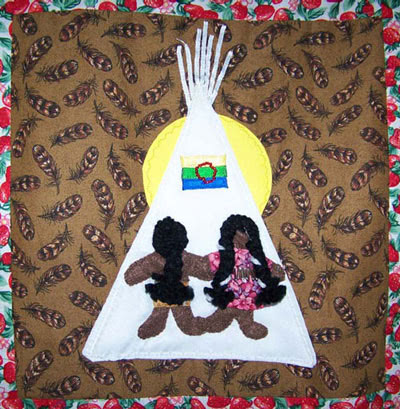Living Healing Quilt Project
Promoting Healing – One Stitch at a Time
My quilt square is dedicated to the Bear and Bird Families and all the other generations of children from our community, Peguis First Nation, who attended residential schools when they began through to the time when they ended.
This quilt square contains a tipi, sun, a little boy and a little girl holding hands, and the colors of the Peguis First Nation flag set on a brown background of floating feathers. The symbolisms contained in these representations are as follows:
a. Tipi – the tipi traditional provided a temporary home, shelter, and teaching lodge for our families moving across the land with the food sources i.e. animals, seasons. It is symbolic of the portability of our rights as First Nations people which ties us to the land through the seasons throughout the year, and it is representative of the homes, families, and communities we left behind during the residential schools period of our history.
b. Sun – the sun represents the one life force that children who attended residential school got to share daily with the parents who were absent from their lives due to the federal government policy of assimilation. Whether the children were conscious about having the sun as connection to their parents or not, it remained the one life force that they could look at and still imagine being with their parents in spirit.
c. Little Boy & Little Girl – represent the beautiful innocence of childhood that was taken from those who attended residential schools and the subsequent resilience of many of our First Nation peoples who have begun to move to a place of healing and recovery. The little boy is turned to look back and the little girl is looking forward; this is symbolic of the importance of our people to remember and acknowledge where we have come from and who we are, as we move forward with the bundles of self-knowledge that continue to give us strength to adapt to whatever may be placed on our path in the present and the future. The little girl has a strand of long white hair (as does my daughter, Irene) which our people believe is a sign of wisdom beyond her years. This strand is symbolic of what may have been the one strand of hope and faith in their blood memory that may have kept their spirit strong. The holding of hands represents the ties between siblings. Unfortunately in many instances these ties were nurtured to deteriorate and be severed while in residential school. The reconnection of siblings and families continues through to today as we move forward on our healing journeys.
d. The Peguis First Nation flag colors are representative of the treaty promises between First Nations and the Queen: yellow, green, blue and the red circle of life. “For as long as the sun shines, the grass grows, and the rivers flow” was a covenant promise that has continued to be misinterpreted. Many First Nations peoples retain these symbols of the Great Covenant and remain hopeful that we may move forward to a renewed relationship and come to mutually reconcile what it means today in 2008.
e. Floating feathers – represent the truth that many of the children carried to the residential school they went to, and the truth that many left with years later. It is these truths that need to be shared today to help us all understand the impact of this period in our history. Time may have helped to heal some experiences but the truths that we all carry today of what happened then remain a truth that needs to be heard. These stories of personal truths continue to be told willingly and reluctantly. And some of the untold stories remain personal truths that only the Creator has witnessed.
Thank you. Megwetch! Ekosi!
Cynthia E. Bird
Peguis First Nation, Manitoba
